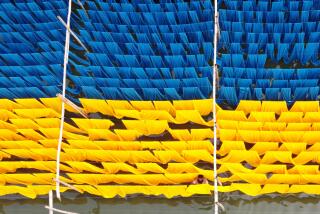A fabric with the power to ward off pathogens
Howâs this for cool threads? Scientists at Lawrence Livermore National Laboratory have been crafting a high-tech fabric for the military made out of tiny carbon nanotubes â hollow structures that stay breathable in hot weather yet are small enough to block out pathogens. For an extra layer of safety, theyâre planning to add a special coating that will block out even the smallest toxins, such as anthrax spores and other chemical and biological warfare agents.
The technology is still in the concept stages, but the research has already received funding from the U.S. Defense Threat Reduction Agency. Itâs easy to see why it appeals to the military: Clothing made out of this material could replace the heavy protective gear that can weigh soldiers down in desert operations. Francesco Fornasiero, a chemical engineer at the Bay Area lab, discussed the technologyâs potential.
Carbon nanotubes have been used to make tougher bicycle parts and stronger epoxy. Why did you decide to use them to make fabric?
We developed membranes which have pores that are made only of carbon nanotubes. These pores have walls that are extremely small. The smoothness of this wall and the hydrophobicity [ability to repel water] are together responsible for the extremely rapid transport rates observed for both gases and liquids.
How fast does it rid itself of anything that tries to stick to it?
For liquids like water, the transport rate of these pores is about 1,000 times or more faster than what you would see in other pores of similar size. For gases, itâs on the order of 100 times faster.
So based on this initial observation several years ago, we started thinking of other applications. This was one of them: breathable fabric.
How does it work?
So these tubes made of carbon span the entire thickness of the membrane and they have a diameter that is tiny, on the order of a few nanometers. [DNA molecules are measured in nanometers.] The material we built is significantly better than Gore-Tex, if you want a comparison for a typical breathable material.
However, breathable fabric has huge pores, much larger than what we have in our membranes. We are able to reject particles as small as five nanometers completely. Biological threats, the smallest ones, are on the order of tens of nanometers.
What kinds of threats are we talking about?
Biological threats could be toxins, could be viruses, could be spores and so on. One of these specifically mentioned by the military is Staphylococcal enterotoxin [which causes food poisoning and has also been considered as a biological warfare agent].
But something must be able to get through, no?
Biological threats cannot fit in. But when weâre talking about chemical threats, then we are talking about components that could be smaller than 1 nanometer in size. And that would be able to go through the pore.
So basically we propose two coatings. The first one is able to recognize the presence of a chemical warfare agent, react with it and as a result of that reaction, it shrinks in volume and ends up blocking the pore. The second concept is based on materials that are actually able to deactivate the threat â react with it and decompose it â and self-exfoliate. You will need a thick enough coating that allows you to use the same garment several times. Itâs like peeling off the protective skin from a surface.
So the fabric is good for more than a one-time use?
We are thinking right now to develop the project for repeated use. The idea is you have your suit, you wear it, you go in a contaminated environment. Then you can do a washing or treatment after you use your clothes to restore the initial conditions.
What does it feel like?
How I can describe it? Itâs like a thick plastic bag, at this stage. But this is not optimized for actual wearing. This is just the material we made to prove that the concept of breathability works.
Do you see yourself wearing it anytime soon?
Itâs too early to say that. But yeah, we hope so.
Our project is for five years. After that, there are going to be a number of other considerations put into place, including mechanical resistance, launderability, wear resistance, the cost of manufacturing, etc. Letâs say we take five years or more. So I would say at least 10 years. It could be easily more than that.
How useful could this âfabricâ be?
I think if we demonstrate that the process really works it would be game changing, because right now what the military uses are garments for protection that are very heavy and not breathable. So as a result, they can only wear them for a short amount of time. Otherwise they may sweat too much and the body temperature goes up too much. Imagine wearing a heavy coat running in the desert when itâs 45 degrees Celsius [113 degrees Fahrenheit].
This interview has been edited for space and clarity.







